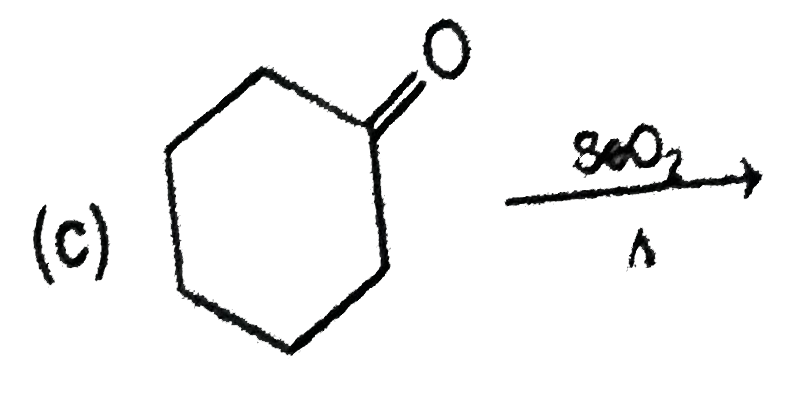Complete the following reaction
RCOOHP2O5−−−−−→Δ?
Acid anhydride
Ketone
Aldehyde
Ester
The correct Answer is:A
To complete the reaction of a carboxylic acid (RCOOH) with phosphorus pentoxide (P2O5) under heat, we can follow these steps:
Step 1: Identify the Reactants
The reactant is a carboxylic acid, represented as RCOOH. Here, R can be any alkyl or aryl group.
Step 2: Understand the Role of P2O5
Phosphorus pentoxide (P2O5) is a strong dehydrating agent. When a carboxylic acid reacts with P2O5, it typically undergoes dehydration, meaning that water is removed from the molecule.
Step 3: Write the Dehydration Reaction
When a carboxylic acid is dehydrated by P2O5, it forms an acid anhydride. The general reaction can be represented as:
RCOOH+P2O5Δ−→RCO−O−CO−R
This indicates that two molecules of the carboxylic acid (RCOOH) will lose a molecule of water (H2O) to form the anhydride.
Step 4: Example with Acetic Acid
If we take acetic acid (CH3COOH) as an example:
- The reaction would be:
2CH3COOH+P2O5Δ−→CH3C(=O)O−C(=O)CH3+H2O
- This results in the formation of acetic anhydride (CH3C(=O)O-C(=O)CH3).
Step 5: Conclusion
Thus, the product of the reaction of a carboxylic acid (RCOOH) with P2O5 upon heating is the corresponding acid anhydride.
Final Answer
The reaction can be summarized as:
RCOOHP2O5,Δ−−−−−→RCO−O−CO−R
The reactant is a carboxylic acid, represented as RCOOH. Here, R can be any alkyl or aryl group.
Phosphorus pentoxide (P2O5) is a strong dehydrating agent. When a carboxylic acid reacts with P2O5, it typically undergoes dehydration, meaning that water is removed from the molecule.
When a carboxylic acid is dehydrated by P2O5, it forms an acid anhydride. The general reaction can be represented as:
RCOOH+P2O5Δ−→RCO−O−CO−R
This indicates that two molecules of the carboxylic acid (RCOOH) will lose a molecule of water (H2O) to form the anhydride.
If we take acetic acid (CH3COOH) as an example:
- The reaction would be:
2CH3COOH+P2O5Δ−→CH3C(=O)O−C(=O)CH3+H2O
- This results in the formation of acetic anhydride (CH3C(=O)O-C(=O)CH3).
Thus, the product of the reaction of a carboxylic acid (RCOOH) with P2O5 upon heating is the corresponding acid anhydride.
The reaction can be summarized as:
RCOOHP2O5,Δ−−−−−→RCO−O−CO−R
Similar Questions
Complete the following
(a) CH3−CHOSeO2−−→Δ, (b) H3C−CH2−O∣∣C−CH3SeO2−−→Δ, (c)
View SolutionComplete the following reactions :
2CH3COOHP2O5−−→
View SolutionComplete the following reactions :
CO(g)+H2(g)Δ−−−−→catalyst
View SolutionComplete the following reactions :
C2H5Br+KOH(alc)Δ−−→
View SolutionComplete the following reactions :
CH3COONa+NaOHCaO−−→Δ...............+.................
View SolutionComplete the following reaction.
(i) CaCO3Δ−−→[A]+[B]gas
(ii) [A]+H2O→[C]
(iii) [C]+[B]→CaCO3+H2O
(iv) NH4Cl+[C]Δ−−→[E]gas+CaCl2+H2O
(v) E+H2O+[B]→[F]
(vi) NaCl+[F]→[G]+NH4Cl
(vii) [G]Δ−−→Na2CO3+H2O+[B]
View SolutionIn the following reaction sequence Y is,
PhOCOCH3AlCl3−−→Δ(X)I2−−−→NaOH(Y)
View SolutionComplete the following reaction sequence :
CH3−O∣∣C−CH3(i)CH3MgBr−−−−−−−−→(ii)H2O(A)Na metal−−−−→ether(B)CH3−Br−−−−−→(C)
View SolutionComplete the following reaction sequence :
CH3−O∣∣C−CH3(i)CH3MgBr−−−−−−−−→(ii)H2O(A)Na metal−−−−→ether(B)CH3−Br−−−−−→(C)
View SolutionComplete the following reactions:
PhCHO+CH3NO2ΘOH−−→Δ(A)
View Solution
